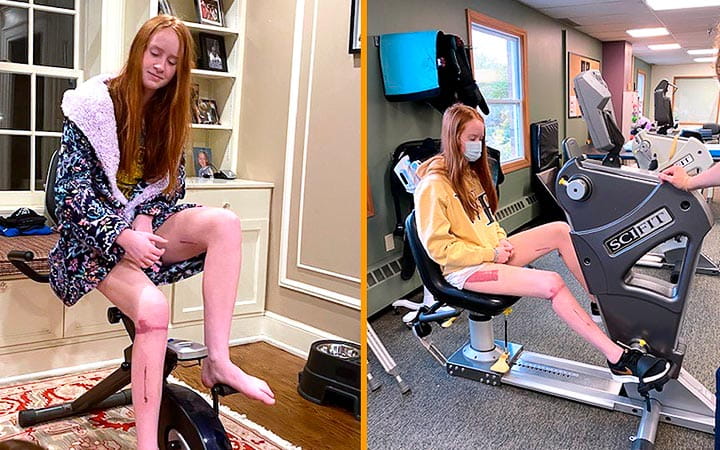Doctors Successfully Reattach Leg Nearly Severed in Jet Ski Accident
May 27, 2021

Just one day after turning 18, in August 2020, Caroline Rarick experienced a horrific trauma.
Celebrating the summer with her volleyball team on Lake Roaming Rock in Roaming Shores, Ohio, Caroline enjoyed the day jet skiing and tubing. Toward the end of the afternoon, around 5 p.m., her friend took off on the jet ski as Caroline stood on the back. A tubing rope got caught around Caroline’s right leg, just below the knee. She was yanked into the water and pulled by her leg for a short distance.
Caroline’s friend stopped the jet ski. Caroline looked down and saw bone with muscle hanging from her leg.
“When I first saw it I was extremely scared. I remember seeing my bone, but I think I was in shock and didn’t completely comprehend what was going on,” she says. “I didn’t feel any pain initially, but I saw the injury and I knew it was bad.”
“In case I pass out, hold me up!” Caroline told her friend as she bobbed in the water, thankfully wearing a life vest.
The pair flagged down another jet skier who pulled Caroline onto his jet ski. None of them had cell phones with them on the water. As they drove toward shore, Caroline’s friend recognized a boat passing by. She knew the owner – a doctor.
They got to the boat and discovered two doctors on board – one pediatrician and one anesthesiologist. They transferred Caroline to the boat, applied a tourniquet and called 911. The doctors detected a slight pulse in Caroline’s leg, but it was growing faint because of so much bleeding.
An ambulance arrived and rushed Caroline to University Hospitals Geauga Medical Center, a campus of UH Regional Hospitals, about 30 miles away. That’s where Caroline’s parents met her.
“The color in her leg was gone, it looked dead,” her mother Jennifer says.
It was decided Caroline would be transported to UH Cleveland Medical Center, where a trauma team was already assembling. When she arrived, they confirmed her artery was completely severed and her tibia suffered a fracture as well.
“Caroline’s injury was extremely severe. Nearly all of the tissue and muscle were pulled from her bone, called a degloving injury,” says vascular surgeon Vikram Kashyap, MD, Division Chief, Vascular Surgery at UH Harrington Heart & Vascular Institute. “She had lost a lot of blood, there was no pulse below the injury, and she could barely move her foot indicating either nerve damage or severe ischemia. The injury was severe enough that we were even considering amputation as the best course of action.”
Her team of vascular, orthopedic and plastic surgeons headed into the operating room at 10 p.m., five hours after the initial accident.
“Heading into the procedure I was really scared, because I finally understood how serious it was. I was terrified I was going to wake up without a leg. I asked my dad if I was going to lose my leg and he didn’t know what to say. There was a pause and that’s when Dr. Kashyap said, ‘We’re not scheduled for an amputation tonight.’ That calmed my nerves,” Caroline says.
During the initial operation, Dr. Kashyap and his team explored the wound, and performed a bypass of the severed artery in the right leg using a vein from the mid-thigh of her left leg. They released the fascia (thin casing of connective tissue) in the lower leg muscle compartments to relieve pressure. Then, pediatric plastic surgery specialist Edward Davidson, MD and the plastic surgery team performed a debridement (removal of damaged tissue or foreign objects from a wound) with coverage of the bypass.
The color returned in Caroline’s leg and her pulse strengthened. Even though the initial operation appeared successful, the odds were against Caroline returning to normal function.
Caroline was in the trauma intensive care unit for four days. She was released from the hospital after 12 days. But she faced a long road to normalcy: multiple debridements, fasciotomy, a wound vac, a skin graft, she fought an infection and faced several more surgeries along the way. Her leg atrophied and most of her remaining muscle disappeared.
For months, Caroline worked with determination and dedication during physical therapy and at-home exercises. Over time, she built strength and graduated from a wheel chair to crutches and was walking independently by Christmastime. In April, she was cleared to attempt jogging.
Caroline missed her senior year of volleyball at Gilmore Academy, but she never lost her positivity.
“Everyone always asks me how I’ve remained so positive. Honestly, when I woke up from the initial surgery and I still had my leg I was just so happy. I was just so thankful to have a leg in the first place. That has kept me going,” Caroline says. “I don’t think it would have been the same outcome if I would have gone anywhere else. I’m so thankful to the doctors and everyone at University Hospitals.”
“2020 was a devastating year for so many people due to the pandemic,” Dr. Kashyap says. “We have seen our share of challenges at UH and many caregivers have witnessed depressing outcomes in patients. I can’t tell you how gratifying it is to see Caroline recover from a life-threatening and limb-threatening accident. She has had a miraculous outcome. She has returned to essentially a normal functional state and is ready to run and participate in competitive sports! Her resilience, positive attitude and mental fortitude should be a shining example for all of us.”
Caroline is thankful to the team of doctors who saved her leg as she prepares to walk onto the campus of Indiana University in the fall of 2021.
Tags: Surgery


